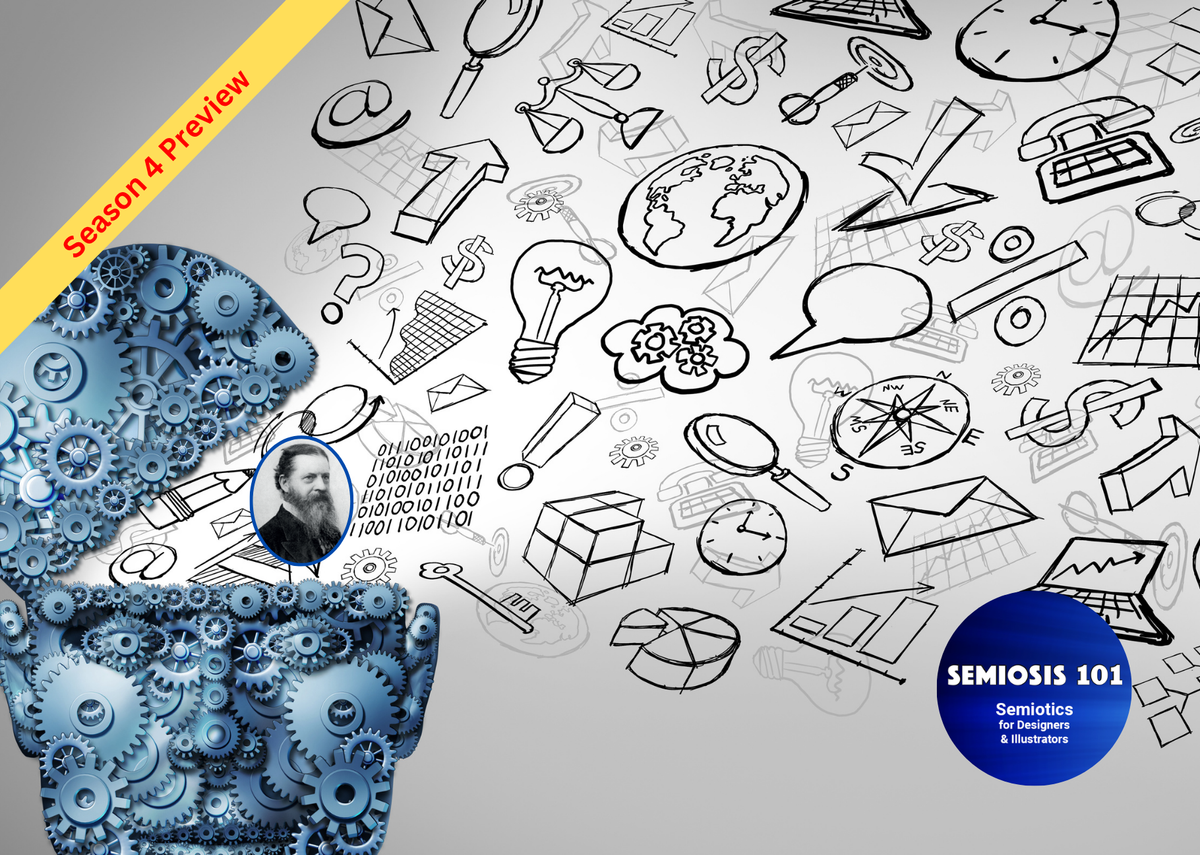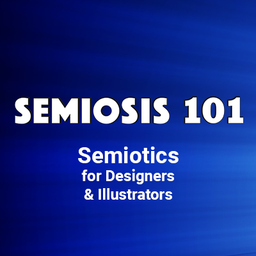Free Semiosis 101 Transcript 4.0:

A Semiotic Frame of Mind: Season 4 Preview
Hello readers.
In this free transcript for the episode published on Semiosis 101 on 5 Dec 2024, we preview the theme of Semiosis 101 season four - A Semiotic Mindset. Over the next twenty episodes, I will answer questions on how a semiotic upgrade to a creative’s existing working process improves their visual communication.
Watch the free episode on YouTube for the full impact…
…and here is the episode’s transcript.
Here we are, with a preview of Season FOUR of Semiosis 101.
Each season has 20 episodes around a semiotic theme. Season one was The Semiosis Box of Tricks. Season two focused on a Semiotic Rosetta Stone. Season three then built on the theory to apply it to encode semiotic signs. What will season four’s semiotic theme be?
Watch and get your head around applying semiotics.
Well, here we are at the fourth season of Semiosis 101. I am Dave Wood, a design educator and researcher. I have been publishing short video episodes to help designers and illustrators to understand and apply semiotic theory in your work.
Why do I do this? Well I have worked as a freelance illustrator and designer before I became an educator. If pushed, I would describe myself as a visual communicator. I became fascinated with how to answer a brief and visually communicate richer meaning …in a smarter way. I had always heard of semiotics, but as soon as I tried to read about the subject and apply the theory, things fell down.
Semiotics is not a single theory, and the language used to explain it is either through a linguistic lens or obtuse.
So Semiosis 101 was born.
In these seasons I theme ways to explain a single, pragmatic and practical semiotic theory in a designer- (and illustrator-) centric way. This theory is Charles Sanders Peirce’s semiotic sign-action - Semiosis. Check out season one videos to find out the difference between Peircean and Sausserian semiotic theories.
Season one set the case for the Semiosis Box of Tricks. Season two framed the need to apply semiotic theory to enhance visual communication, through a Semiotic Rosetta Stone metaphor. Last season’s theme, which has just concluded, focused on Encoding Semiotic Signs. In season three I unpacked more of Peirce’s theory in designer-centric ways, to demonstrate that as creatives …we have ALWAYS been working semiotically.
We have just not been aware and not understanding how to apply it with more success.
In season four the theme will be a Semiotic Frame of Mind. What I mean by this is that, if as I argue designers and illustrators have always been working semiotically in some capacity, how do we do it …better? Back in episode 3.17, I framed Peirce’s semiotic sign-action power through three lenses of Perception, Communication and Delivery. This triadic inter-relationship is key to understand pragmatic semiotic communication.
As designers and illustrators, we are always visually communicating something to someone, so in season four we will play a game of twenty questions. Each episode will answer a specific question on applying semiotics. This is about gaining knowledge to develop your own semiotic frame of mind. Applying Semiosis in your ideation stages of sketching first needs a lateral step in understanding …that semiotics is natural.
These 20 season four questions will be grouped into six sub-themes, which will help you step your way toward a new semiotic frame of mind. Season four’s first three episodes prepare you to form A SEMIOTIC FRAME OF MIND. The questions each episode addresses under this theme will be:
4.1 How Do We Visually Communicate …THIS? *
(The THIS?* in this question being whatever you need to visually communicate).
4.2 How Can We Clearly Convey VISUAL Meaning?
(In which we will quickly explore the Semiosis box of tricks).
4.3 How is a Small Perspective Change Advantageous?
(You will be surprised by how a small change in thinking opens up semiotics to you).
These questions will put you in a good place, to then see how Peirce’s semiotic sign-action (Semiosis) can be applied to existing creative practice.
That is the emphasis …”existing creative practice.
Semiosis 101 intends for illustrators’ and designers’ to be enhanced WITH Semiosis rather than telling you to unlearn the skills you have. So in this spirit, the next sub-theme will focus on SEMIOTIC SIGN-ACTIONEERS. In other words …how you creatives proactively embed semiotic sign-action into your existing practice.
You went to design school, you learnt to illustrate and design, you may be working as an illustrator or designer right now …so from the next three questions you will discover how second-order thinking AND Semiosis help you to enhance your existing creative practice.
Yes, in season four I have taken a semantic turn, in which I will demonstrate that Semiosis employs second-order thinking, to improve our ability to visually communicate. This is contrary to how some designers see semiotics! To demonstrate how a small change in designers and illustrators perspectives to what semiotics - well Semiosis - can do, I will answer the following questions:
4.4 How Will Audience Perspectives Benefit Our Creativity?
(Yes, change your creative perspective through your audiences’ perspective).
4.5 How Can Hypothesis Improve Creative’s Ideas?
(We see how the Logic of Design is your semiotic friend).
4.6 How Can People Rapidly Grasp Visual Meaning?
(With a new small, micro semiotic awareness your audience can be hooked).
It is now, at this stage of the micro decisions during ideation, that Peirce’s semiotic theory can accelerate your creative choices in visual meaning-bearing. Therefore, the next sub-theme of questions focus on simple things. The lowest level of semiotic communication. You know, the initial things you already sketch when starting any new creative project!
We will then be in a position to begin delving into some semiotic fundamentals, which separate Peirce’s Semiosis from the more widely known, linguistic-based Semiology. Semiosis (semiotic sign-action) directly involves the interpreter …the audience.
Semiology (signifier/signified) is dyadic.
However, Semiosis is triadic.
In designer-centric terms and contexts, Peirce’s Semiosis happens between the client, the creative AND the audience at a macro level. So, there will be three episodes preparing your creative mind to this, by focussing on SIMPLY, THINGS… as micro semiotic inter-relationships.
4.7 How Will Audiences Commit Their Attention?
(Yes, audiences and designers are in a looping semiotic relationship).
4.8 How Do We Hook More Audience Awareness?
(Creatives can semiotically enhance how audiences’ visually engage).
4.9 How Does Imagination Visually Aid Meaning?
(Things can be your semiotic meaning-bearing allies).
…then you will be ready for the audience’s turn.
The next four episodes sort of flips the conversation from the creative to the audiences’ mindset. It is crucial to consider who you design or illustrate for. By understanding the audience’s cultural cues will help you to work both laterally and embrace second-order thinking. So, to help you reframe your own semiotic mindset we will take some time to look for SEMIOTIC CULTURAL CUES in the audience. The four questions I will use are:
4.10 How Is Meaning in the Eye-of-the-Beholder?
(Culturally, are your visuals communicating what you intend?)
4.11 How Can Ephemeral Qualities Be SO Important?
(Let us go to the edges of perceiving to semiotically strengthen communication).
4.12 How Do Contexts Affect Visual Meaning?
(Understanding the semiotic power across different types of audience).
4.13 How Can Other Points-of-view Enhance Our Creativity?
(Breaking first-order thinking in your semiotic ideation).
Now that we will have looked at the mindsets of both creatives and audiences, I will be ready to mix-metaphors and pun my way through another four episodes around the sub-theme of a SEMIOTIC TROJAN HORSE. We will saddle up
>sorry<
and ride this theme
>sorry<
across the range
>again, sorry<
of possible ways to hide meaning-bearing semiotic signs in plain sight to enhance visual communication.
4.14 How Can We Second-guess Audience Understanding?
(Visual communication semiotically hitching a ride to facilitate meaning).
4.15 How May We Communicate Complex Messages Simply?
(Semiotically clarifying complexity through effective sign-action).
4.16 How Can the Audience Help Our Messaging?
(The audience already know stuff so we have a semiotic short-hand).
4.17 How Will Engaging Our Audience’s Intuition Help?
(The “Well, THAT looks like THIS” enigma).
So, later in the year we will reach the end of season four and be able to summarise how, with Peirce’s Semiosis (and Semiosis 101), we been CREATIVELY CRAFTING A SEMIOTIC MINDSET in you creatives. The final three questions will be:
4.18 How Will We Strengthen Our Message’s Impact?
(The crafting of a semiotic mindset).
4.19 How Does Semiosis Change a Creative’s Mind?
(Small simple changes lead to fresh positive impacts).
4.20 How Far Have You Reframed Your Creativity?
(A review of how far you have changed your creative mindset).
Remember to subscribe to Semiosis 101 on YouTube to be notified when the weekly free episode is published. Or become a Semiosis 101 Producer on Patreon and watch all future episodes months ahead of YouTube …plus other exclusive content and gifts. Hint… hint…
Semiosis 101 Semiotic Design Resources is a reader-supported publication. To receive exclusive posts and support my work, consider becoming a free or paid subscriber. Paid subscribers get name checked on all future Semiosis 101 YouTube episodes.
===Semiosis 101 Patreon Producer==============
Become a Semiosis 101 Patreon Producer and get a named producer credit on future video episodes, plus watch all new episodes months ahead of YouTube.
===Semiosis 101 Patreon Exclusives==============
Watch longer Patreon-exclusive Semiosis 101 episodes on applying Semiosis into design and illustration…
PATEXC001 How does semiotics work in illustration?





